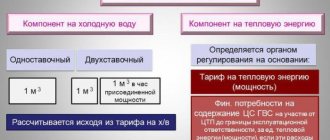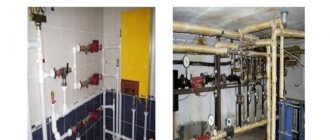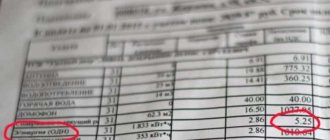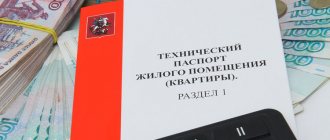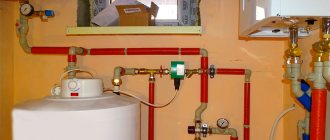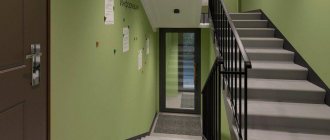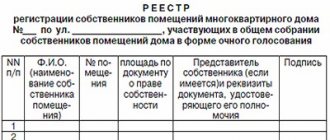Receiving monthly receipts for utility bills is a common occurrence. And before the great growth of communal services, rarely did anyone think about what this or that housing and communal services abbreviation meant on receipts and what the total amount was worth.
But increasingly, apartment residents are carefully looking at the invoice and contacting the Management Company or another utility service regarding tariff changes.
Homeowners have many questions regarding the column in their payment slip with the abbreviation GVS on ODN. Separately, these designations are clear. But what does “ONE: hot water supply” mean? According to the rules, such an article indicates the payment for hot water spent on the needs of the house as a whole, on ONE .
You need to know that the same receipt will also include the amount for cold water, also spent for general household needs.
Definition
What is in the ODN receipt and what does this payment consist of? The billing department of the service company includes the costs of electricity, heat supply, hot and cold water spent on servicing common property in the payment for one-room service. For example, residents need to pay for light in the hallways or water, which is needed for cleaning staircases.
ATTENTION! Payment of ODN by residents of the house complies with the norms of housing legislation.
Calculation of ODN for electricity in an apartment building
As already mentioned, from January 1, 2021, the payment for one-person tax has been transferred to the category of expenses for the maintenance of common property, which means that the one-person line in the receipt should disappear. Now let's define what common property is. It is strictly defined by Article 36, Clause 1 of the Housing Code of the Russian Federation and includes all premises of an apartment building that are used for public use, excluding apartments:
Most apartment buildings are already equipped with common building meters for metering the consumption of utility resources (electricity, water and heat). Many apartments have individual meters, according to which residents submit readings and utility bills are calculated. Essentially, common house needs are the difference between the readings of common house and individual appliances. For those owners who do not have meters in their apartment, ODN is distributed based on the ratio of the apartment’s area to the total living space of the house.
Hot water consumption
Maintenance of apartment buildings is a complex process, including repair, cleaning, excavation and other work. Some of them require hot water, the consumption of which is paid jointly by the residents of the house:
- The entrances of residential buildings and staircases are heated with hot water in the heating supply network.
- DHW is necessary for pressure testing of the heating system after completion.
- Hot water is used when checking the system before the heating season begins in the house.
- It is also consumed when water is discharged in risers when repairs to the system are carried out.
DHW consumption can be determined by comparing the readings of the common house meter and the sum of the readings of the meters in the apartment. This difference is included in the payment for general household needs.
IMPORTANT! From 2021, the ODN column may be absent from the invoice receipt, but this does not mean that now the consumption of hot water or cold water for general household needs does not need to be paid.
According to the new law, such costs for hot water supply are distributed proportionally between apartments. Payment amounts are determined at the regional level and may differ in different cities, but the payment will be fixed.
Those who decided not to pay for such general expenses will now not be able to do this, since the rent debt in general will accumulate. Failure to pay for DHW may result in hot water being cut off to the apartment.
General household needs - water
The information presented will be relevant in 2021, 2021, 2021 and other years, since data for the cities of Novosibirsk, Moscow, Omsk, Moscow region, Perm, St. Petersburg, Chelyabinsk, Kaliningrad and other cities in Russia and Ukraine are constantly updated. It is also worth noting the fact that the new law has not been repealed, although some media outlets wrote about it, but the price actually increases for all services.
The Heating Company charges us 17.4 m3 per month for hot water (to wash 4 entrances on five floors once a month) plus 17.4 m3 of cold water plus drainage of 34 m3. If we don’t pay, we are already suing in an arbitration court, we wrote to the Ministry, the State Duma, and the Federation Council. Everything is sent to our government, and they refer to the Ministry.
How is ODN calculated?
Decoding ODN shows that this column pays for the consumption of resources and services necessary for the entire house. What does the total amount consist of? The payment includes not only water, but also heat, electricity, and may additionally include security and more. It is important to know how the calculation is made for all the components of the graph.
The payment is calculated taking into account the readings of the common building meter and other metering devices installed in the apartment building.
Metering devices must work in every apartment building; this is a legal requirement. The exception is those houses in which the installation of hot water meters is impossible for technical reasons.
Despite the legal requirement for the mandatory installation of meters, not all houses are yet equipped with them. Accrual of hot water for general house consumption in such apartment buildings is carried out according to standards.
The standard is established by regional and local authorities; this information must be available to consumers, so it is published on the website of the Management Company or other service organization. Why are standards developed?
Companies that service a house without metering devices can charge the DHW payment to the ODN at their discretion, dishonestly, trying to write off their expenses. And regulations are a reliable means of protection against such fraud.
And yet, it is more profitable to install reliable and accurate metering devices; they will show the actual amount of expenses, help identify leaks, and save payments for apartment residents.
What does drainage mean on an apartment receipt?
Frequently asked questions regarding the calculation of ODN standards
Answers on payment for one-time tax. Photo No. 3
Despite the fact that this tariff was conceived as a payment for water resources that are used for the maintenance of houses, it is not formed transparently, which is why many utility companies try to inflate the consumption standards of ODN.
Let's look at frequently asked questions. The first concerns calculation schemes. There are several formulas for calculating ODN, but none of them are perfect and there are many ways to confuse consumers.
It’s easier for those who have an apartment building equipped with a common building meter for cold and hot water. Having it, utility consumers can always compare how much water entered the house, as well as the amount spent by all consumers. Accordingly, the difference will be the amount of one.
Those houses that do not have communal metering devices will pay for ODN based on calculations from utility service providers. The formula for them is as follows - H = x K / C.
N is the value of ODN for a specific consumer facility (that is, per personal account), this is a standard number used for all calculations, K is the total number of citizens living in the house, C is the total value of all residential and non-residential in a particular apartment building .
As can be seen from this formula, it will not reflect an accurate indication of the water used to service the house and its utilities.
The next question concerns payment for services not provided. For example, there are situations when there is no water in the house due to repair work on the central water supply, or other breakdowns, and the received payment contains one. No need to panic. It is enough to submit a statement in the form of a claim to the utility company supplying water.
Management companies are required to be guided by the Decree of the President of the Russian Federation, which introduced Federal Law No. 258 of July 29, 2017 (published on July 30, 2021). Based on the law, the calculation of ODN amounts is carried out either according to meters or according to regional standards.
Note! If the meter is installed, then the management company has no right to ignore its readings, nor to demand from the residents of the house an amount in excess of the services actually consumed.
At the moment, accruals for one-time tax written down in the payment receipt are considered mandatory payments. Based on Article 158 of the Housing Code of the Russian Federation, each owner of residential premises in an apartment building must pay costs related to common property and its maintenance.
Failure to pay money for one-time service tax leads to the citizen’s debt, in connection with which utility services have the right to turn off the supply of housing and communal services to the apartment.
The management company may go to court to forcefully collect the debt from the owner of the residential premises.
The consumption of resources for collective needs falls within the scope of public services in the same way as their individual consumption. In this regard, the supplier of electricity, water, gas, heat or management company has the right to file a claim against apartment owners in a judicial authority or limit the supply to those residents who ignore bills until the debts for payment of general house needs are fully covered .
An analysis carried out by specialists in the field of housing and communal services showed that payment for resources consumed by SOI can either increase or decrease. At the same time, both decreases and increases were insignificant. Management organizations may observe that in houses of the same type the accrued amounts are not the same. Payment is largely determined by the total area of premises related to common property. This parameter is individual for each home, so the amount of expenses will be different everywhere.
Lamps that illuminate the previously listed common areas in and around the house consume a certain amount of electricity. Also an elevator and other communications that are in common use. Of course, these are expenses, and far from small for a year. These ODN are distributed to all owners of residential areas of the house.
Calculation formulas
How the ODN for water is calculated depends on the presence/absence of a common house meter.
In the absence of a common meter, the payment is calculated according to the standards, while the algorithm in accordance with each standard is given in the Order of the Ministry of Energy and Housing Complex. In schematic expression, the formula for calculating ODN for hot and cold water in this case looks like this:
- Regulations
- Letters
- Orders and decisions
- Codes of the Russian Federation
- Federal laws
- Heating calculation
- Calculation of cold water supply
- Calculation of hot water supply
- Calculation of power supply
- Gas supply calculation
Payment calculation formula
According to Government Decree No. 344 of April 16, 2013, water costs are paid according to the general principle of calculating the supplied resources for each resident. The formula for calculating payment for hot water consumption for general household consumption is simple for those houses that are equipped with modern metering devices.
To calculate the payment, you only need to calculate the difference between the readings of the common building meter and the sum of the indicators of the IPU of the apartments in the apartment complex. This difference is multiplied by the current domestic hot water tariff. The resulting number is divided among the residents of the house, and the area of the housing is taken into account. Thus, there is a proportional division of the payment between all owners or tenants.
A slightly different principle for calculating payments for hot water in residential buildings without meters. To obtain the required number, the standard established by the regional authorities is used. It is multiplied by the area of common property, and then this number is also divided among residents according to the area of their apartments.
In order for the distribution to be fair, you need to have accurate data on the number of persons assigned to each apartment, and accurate data on the square footage of individual housing.
ATTENTION! The payment for hot water supply for single use in apartment buildings without meters should not exceed the legally fixed average consumption standard.
If this indicator is exceeded, the difference must be paid by the Management Company or the resource supplier. As an option, apartment owners at a general meeting voluntarily decide to pay the overexpenditure. This is possible if they know the reason for the increase in the amount and consider it serious.
Cold and hot water supply ODN - what is it?
- Floors, number of entrances.
- Wear and tear of the in-house communication system.
- The size of the adjacent territory served.
- Heat supply.
- Hot water supply.
- Supply of residential premises with specialized devices.
- Heated towel rails, risers (insulated, non-insulated).
- Common appliances and water in a high-rise building.
- They take a certain indicator of consumption by this housing construction.
- Then they multiply the recorded numbers by meters of collective use.
- The resulting numbers are multiplied by the ratio sq. m. of a certain apartment to collective residential and non-residential premises in the house.
Ways to reduce the amount
The accrual of ODN is regulated by Government Resolution No. 354 (which entered into force on May 6, 2011). Water heating, heating, supply of hot water to apartments - all these works require significant consumption of thermal energy. And therefore this column in the invoice always consists of a large amount.
But is it possible to somehow reduce the payment without reducing the comfort of living in the house and the quality of its service? There are several ways to save family finances:
- The first step is to install metering devices on the hot water supply. The ideal option is IPU in apartments and general building meters, which will help accurately calculate the hot water consumption for the needs of the entire house. You just need to find out at whose expense the device will be installed.
- It is recommended to insulate the basement and other common areas.
- Replacing old metal pipes with polypropylene ones will also help.
- In order for DHW for general house needs to be calculated correctly and according to the meter, the data from the meter must be transmitted on time. Otherwise, the settlement department will make calculations according to the standards (with subsequent recalculation upon receipt of meter readings).
- Control over the work of the Management Company and resource suppliers is also a method of saving. A representative of the house can check the taken meter readings and check compliance with the monthly accrual.
It should be taken into account that payments, which depend on the number of people living in the apartment, may increase. If an unassigned person lives in an apartment without an IPU for more than 5 days, the Management Company has the right to charge such person payments according to the standards.
For this, it is enough for the House Council to record the fact of residence of such a person and submit the corresponding act to the settlement department.
Installation of a common house meter makes it possible to identify resource leaks. The leakage volume should be subtracted from the total DHW consumption at the ODN. Correcting leakage problems is the responsibility of the service company. In apartment buildings without meters, it is the residents who pay for wasted water losses.
What is thermal energy for hot water supply?
Regarding this concept, the following can be noted:
- It is completely logical that in order to heat water to the required temperature, you will need to expend a certain amount of energy; in fact, it is this expended energy that we are talking about.
- The amount of energy spent on hot water supply is determined by applying the calculated value, which is approved by the organization acting as the heat supplier.
Note! Cases of fraud in the housing and communal services sector are quite common. Therefore, it is imperative to pay attention to what is written on the receipts, first of all, in order to save your money.
Didn't find the answer to your question? Find out how to solve exactly your problem - call right now: +7 (Moscow) +7 (812) 309-53-42 (St. Petersburg) It's fast and free!
Is it possible not to pay?
The ODN issue became a point of contention for several years.
Many residents do not consider it their responsibility to pay for the costs associated with maintaining their own home. They consider only payments relating to expenses within the apartment to be legitimate. But general house needs are related to ensuring safety, excellent technical condition of an apartment building, ensuring sanitary and hygienic conditions in it, and heat in common areas.
In connection with the disputes that are ongoing regarding the payment of one-time tax, it was decided at the state level to cancel this column in the invoice and add the payment for expenses to the corresponding payments for the apartment. Therefore, ODN must be paid, but in a modified form.
The accrual of ODT has a fair justification, because payments for common property and the costs of its maintenance must be covered by the owners of the apartments in it. These are expenses for their property. And besides, the obligation to pay for utilities on time is enshrined in law and stipulated in the agreement with the Management Company providing the services.
General house needs for - water: pay - or - not
The consumer of utilities in an apartment building, regardless of the chosen method of managing the apartment building, as part of the payment for utility services, separately pays for utilities provided to the consumer in residential or non-residential premises, and for utilities consumed during the use of common property in an apartment building home (hereinafter referred to as utilities provided for general house needs). “Rules for the provision of utility services to owners and users of premises in apartment buildings and residential buildings”, Decree of the Government of the Russian Federation dated May 6, 2011 No. 354
As a rule, the consumption of cold water supply exceeds the consumption of hot water. This is due to the fact that cold water is the main water supply in an apartment building, and hot water is obtained by heating cold water and is supplied in the volume that is necessary to obtain the desired temperature.
Hot water supply
It's important! Despite the fact that the formula for accounting for general needs is quite simple, in practice the real data is often several times higher than the calculated data. The reasons for this are increased losses of customers due to the unsatisfactory condition of the network and the actions of residents in whose apartments metering devices are not installed. For example, residents take advantage of the fact that they are obliged to pay according to standards, and stop saving altogether - they do not turn off the water, and additionally heat their homes with a gas stove. In other cases, 4 people can live in an apartment, but only 1 is registered. Accounts will be charged according to the norms per user, but in fact, use There will be four communal services.
How is ODN calculated if there is a store or restaurant in a residential building?
After this, apartment meter readings are collected, water consumption for each apartment and the total amount of water used by all residents are calculated. The indications of general and individual accounting are compared, the difference between them is the expenditure for general needs.
- There is no need to use more than one refrigerator. It does not need to be installed close to heating appliances, nor does it require storing heated foods.
- When calculating energy consumption, the rated power of electrical appliances is taken. In fact, old equipment requires more energy than new ones.
- Effectively use multi-tariff meters, shifting maximum energy consumption to night time.
- The use of energy-saving lamps allows you to significantly save on lighting. But you should take into account how much the lamp costs. It may be more expensive, but its high technical characteristics create certain advantages. In addition, the load on the wiring is reduced, which is also important.
- Name and location of the service provider.
- Last name, first name, patronymic, residential address and contact telephone number of the consumer.
- Circumstances of the transaction - the date and place of conclusion of the contract, its value and subject matter, rights, obligations and responsibilities of the parties.
- Circumstances in connection with the occurrence of which it is necessary to recalculate, for example, unjustified suspension of the service.
- The reasons that gave rise to them. Here you can indicate work that was not necessary.
- The period for which recalculation must be made.
- List of attached documentation.
- Date of compilation and signature of the initiator.
Canceled or not in 2021
2. The volume of general house drainage is determined as the sum of the volumes of individual “sewage” of the premises of the apartment building, without taking into account the readings of the hot water supply and hot water supply. The basis is subclause “c” of clause 21 of the RF PP dated 02/14/2021 N124 (hereinafter referred to as Rules N124) , which in turn refers to the RF PP dated 05/06/2021. N354 (hereinafter referred to as Rules N354). In this case, of course, no difference arises between the sum of the volumes of individual “sewage disposal” of the premises of an apartment building and the general building volume of water disposal, and the concept of “sewage disposal on one single building” does not exist with this calculation method.
You might be interested ==> Living wage per child in 2021 in the Voronezh region
The owners have the right to discuss this fact at the general meeting. Residents need to take the initiative and create a council of apartment buildings or an initiative group from among the owners to jointly take readings from communal and individual metering devices (meters). The interaction of all residents of the house with the management organization is important. The fight against high fees for road traffic access stimulates residents and management organizations to take measures to save energy and increase energy efficiency.
In accordance with Art. Art. 30, 39, 154 of the Housing Code of the Russian Federation, the burden of expenses for the maintenance of common property in an apartment building (hereinafter - MKD), including utilities for common house needs (hereinafter - ADN), is borne by the owners of premises in the MKD. The share of such expenses is determined by the share in the right of common ownership of common property in the apartment building in which the owner lives.
The principle of payment in MKD
According to clause 44 of Rules No. 354, the volume of utility services provided to one public service station during the billing period, distributed among consumers, cannot exceed the volume of utility services calculated on the basis of the consumption standards of the utility service provided to one's own one, except in cases where the general meeting of premises owners in the MKD, carried out in the prescribed manner, a decision was made on the distribution of the volume of utility services in an amount exceeding the volume of utility services provided to the one-room service.
- HVS. Maintenance of flower beds and lawns, maintaining cleanliness in entrances and office premises, cleaning sewers and other household needs.
- DHW. Activities related to the preparation of residential buildings for the heating season, that is, checking heating systems by releasing hot water, repairing radiators.
